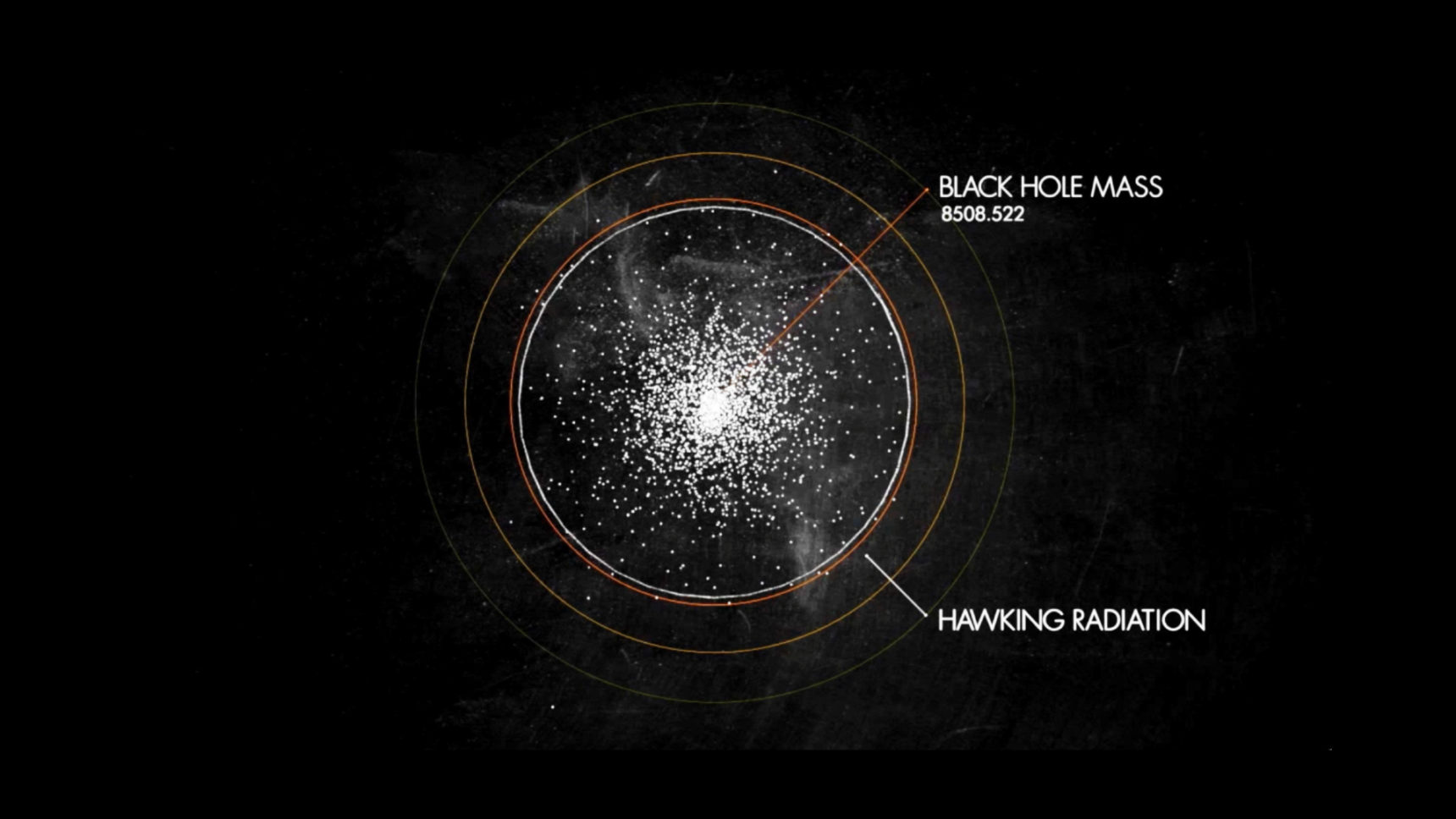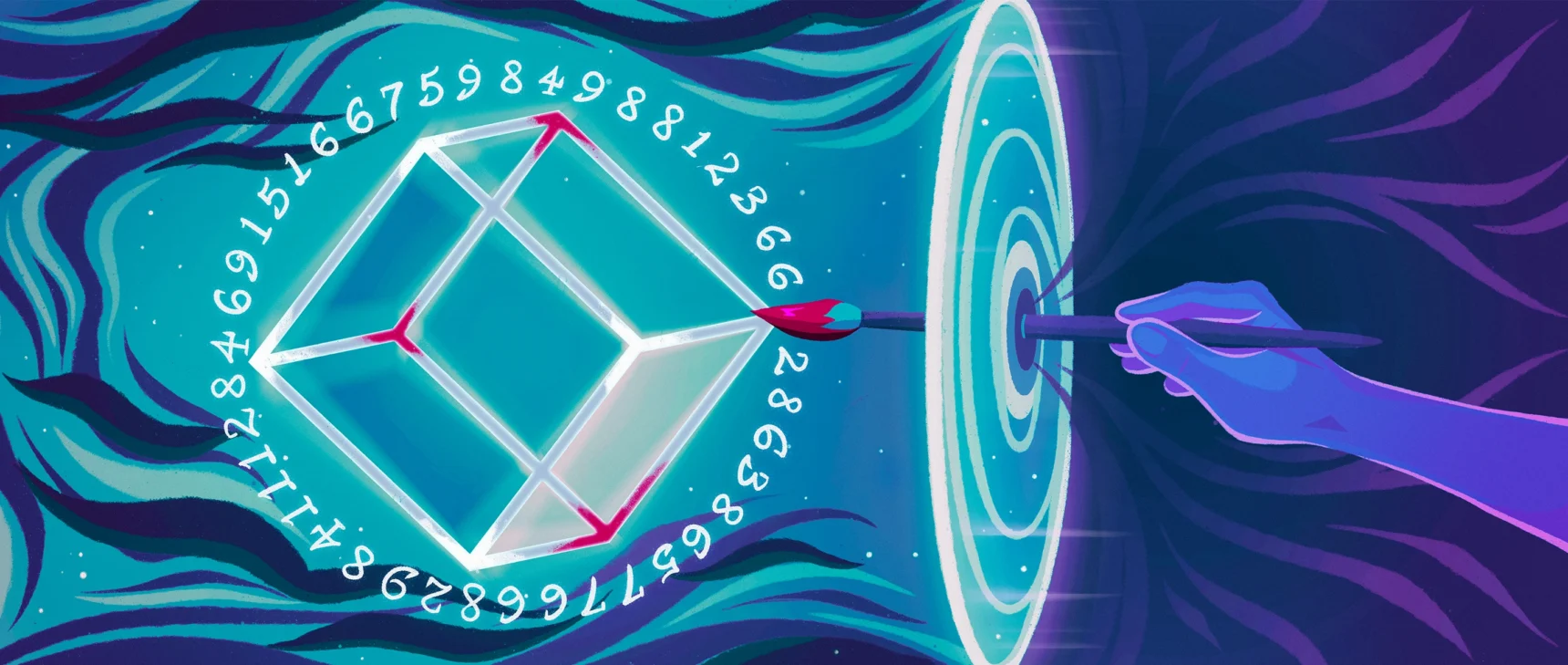Quantum Complexity Shows How to Escape Hawking’s Black Hole Paradox
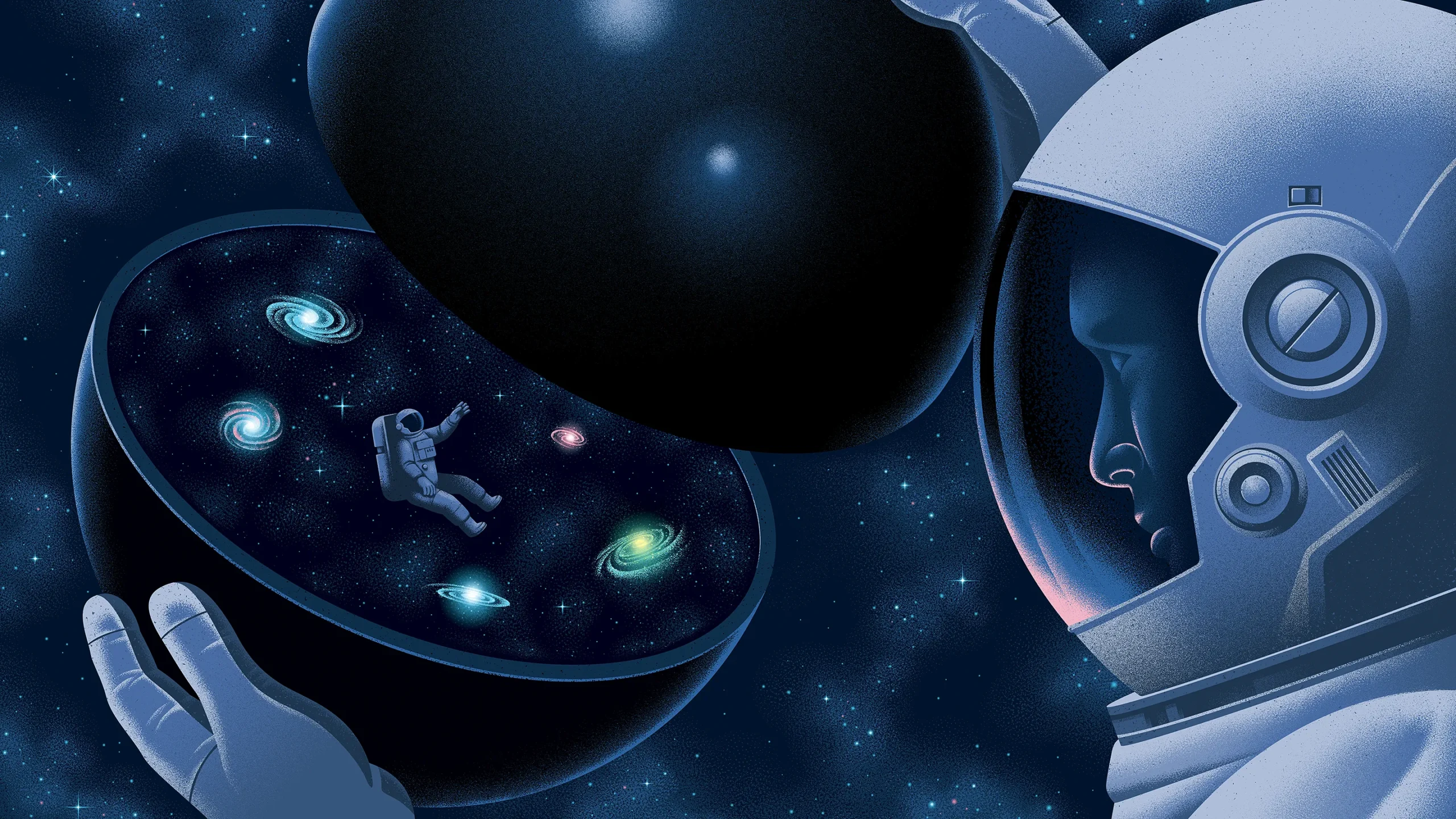
Would an astronaut inside a black hole describe the same reality as an astronaut outside?
Kouzou Sakai for Quanta Magazine
Introduction
In August 2013, dozens of renowned theoretical physicists gathered in Santa Barbara, California, to discuss a crisis. Their tenuous understanding of black holes was falling apart. Viewed from afar, as if through a telescope, a black hole should behave like a planet, a star, or any other conglomerate of elementary particles. But if the physicists believed the work of Albert Einstein, as most of them did, then impossible consequences came about when they considered the black hole from the viewpoint of someone just inside its boundary.
A thought experiment the previous year had sharpened this clash of perspectives, abruptly ending a two-decade armistice between those who believed the exterior view to be the fundamental one and those who focused on the view from inside. Suddenly, all manner of sacrosanct physical beliefs were up for debate. Those behind the thought experiment suggested, desperately, that black hole interiors might simply not exist — that space-time ended at the edge of the black hole in a literal wall of fire.
As an extension of that thinking, one attendee at the conference even suggested, largely in jest, that the paradox seemed to imply that the known laws of physics might just break down everywhere all the time, an observation that earned a Comedy Cellar–worthy laugh. One of the more junior participants, Daniel Harlow, took the mic and reacted with a single incredulous “Dude,” before guiding the conversation back to less heretical ground.
“There was just a flurry” of brainstorming, said Patrick Hayden, a computer scientist turned physicist at Stanford University. “People’s willingness to go out on a limb with crazy ideas was shocking.”
After another decade of arguing and calculating, Harlow, now a senior physicist at the Massachusetts Institute of Technology, believes that he and a team of up-and-coming theorists have finally found the way, or at least a way, of squaring the exterior and interior views. In doing so, they have established something of a détente between the warring worlds of relativity and quantum theory. Their resolution, which weaves together far-flung ideas from quantum information theory and breakthrough calculations from 2019, is a headache-inducing and hard-won attempt to have the outside and keep much of the inside too.
“They’ve succeeded in showing that at least in principle, this tension can be resolved,” said Tom Hartman, a physicist at Cornell University who has found a flagship feature of their theory in another model of gravity.
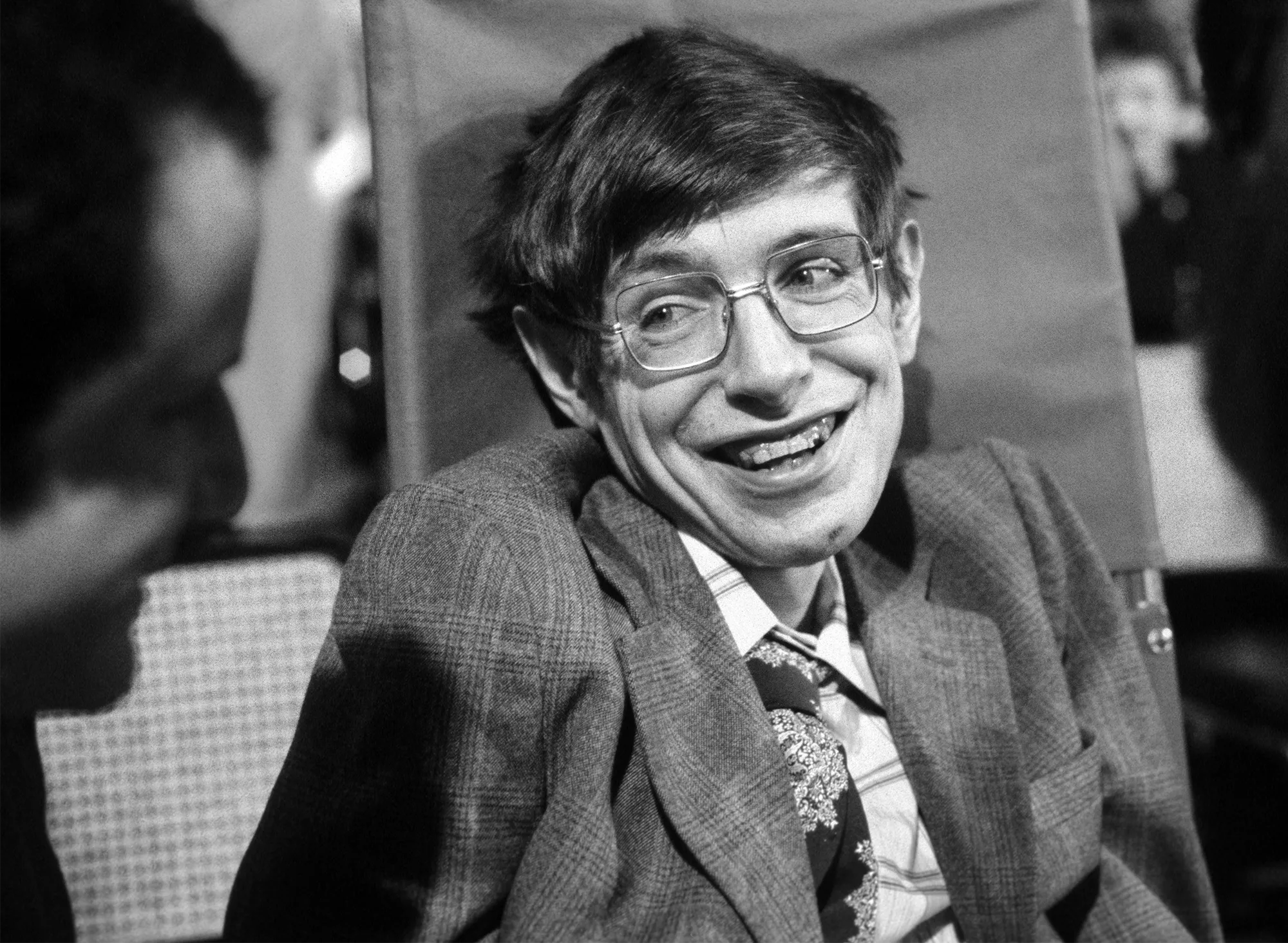
Stephen Hawking predicted that black holes emit radiation, sparking a debate that has continued for 50 years.
Santi Visalli/Getty Images
While their procedure currently works only with a bare-bones caricature of a black hole, it captures many of the peculiar features of the collapsed stars. If it holds for real black holes, it will conclusively answer a gauntlet of classic black hole questions, from what an astronaut would experience as she fell into a black hole to the ultimate fate of the information contained in the arrangement of her molecules.
“It represents to some degree the end of a revolution, rather than a beginning,” said Geoff Penington, a physicist at the University of California, Berkeley and a contributor to the new work.
“It’s very exciting. It could be wrong, but I think this is the right essence,” said Oliver DeWolfe, a physicist at the University of Colorado, Boulder and one of a handful of researchers who have built upon Harlow and company’s proposal in the last year.
The group strives to save the black hole interior from outright sacrifice by inflicting a flesh wound: In an ironic twist, Harlow and company propose that the familiar laws of physics do break down inside a black hole — and perhaps everywhere all the time. But they do so in a previously unknown way, one too subtle for anyone to have noticed. At root is a constraint not from matter or the stuff of space-time. Rather, it comes from arguments concerning complexity — the essentially unending possibilities contained in vast volumes of quantum information.
From Hawking Radiation to Firewalls
One session at the Santa Barbara workshop was led by the principal architect of the black hole revolution. Skyping in from his Cambridge office on an expansive projector screen, a larger-than-life Stephen Hawking defended the notion that space and time survive inside the black hole interior. “Some time ago, I wrote a paper that started a controversy that has lasted until the present day,” he began.
That controversy centers around the way that black holes seem to be stages for the greatest vanishing act in the universe.
In 1974, Hawking calculated that around the event horizon — the sphere of no return surrounding a black hole — quantum fluctuations create pairs of particles. One partner falls into the black hole while the other escapes. Over time, the partners pile up both inside the black hole and outside, where they take flight in an expanding cloud of “Hawking radiation.”
The trouble began with the fact that under the terms of quantum mechanics, each duo is linked by entanglement, meaning that the two particles jointly carry one unit of information. Each partner is like the face of a coin, which might be used to answer a yes-or-no question. This single yes-or-no capacity is called a “bit,” or a “qubit” if the object can exist in a quantum combination called a superposition. But unlike the two faces of a coin, entangled particles can separate. Still, if one measurement finds an external partner reading “heads,” another measurement would be sure to find the internal partner reading “tails.”
That appears to conflict with a second consequence of Hawking’s calculation. As the black hole radiates particles, it eventually evaporates away completely. After untold eons, only the cloud of radiation remains. But because each exterior partner shares one bit with its interior partner, the Hawking radiation alone makes as little sense as a piggy bank full of one-sided coins. The qubits of information inside the black hole, which record the life of the black hole and all that has fallen into it, seemingly disappear — a preposterous development.
“It’s fine as long as that stuff is inside somewhere,” said Samir Mathur, a physicist at Ohio State University and one of the coordinators of the 2013 conference. “But if the black hole disappears, the guys outside don’t have any definite states at all.”
The puzzling demise of old black holes led physicists to adopt one of two clashing views, depending on whether their loyalties lay with Einstein’s theory of curved space-time, known as general relativity, or with quantum mechanics. Hawking, for many years, bet on Einstein. If trapping particles and erasing their qubits violated a quantum mechanical ban on one-sided coins, Hawking believed, then so much the worse for quantum mechanics.
Others preferred to keep their mind’s eye outside the black hole. They sided with quantum mechanics, which rigorously guarantees the romantic notion that information is never truly lost. After burning a diary, for instance, one can imagine capturing the cloud of smoke, ash and heat and reconstructing the lost sentences. A black hole might scramble a diary’s particles more violently than a bonfire, but the same logic would apply. If the Hawking radiation was all that was left, then the text’s information must have leaked out into it somehow — never mind that Einstein’s theory of space-time requires it to stay trapped inside.
The final piece of the paradox was that Hawking’s analysis had found the radiation to be perfectly random — devoid of any information to decode. His work suggested two conflicting conclusions: that black holes evaporate (implying that radiation should eventually carry away the information), and that the radiation does not carry information. They couldn’t both be right, so most physicists assumed that Hawking had erred somehow.
But his mistake wasn’t an obvious one. Hawking had discovered both the radiation and its randomness by analyzing the way quantum fields act in a gently curving space-time — a rigorously tested framework known as semiclassical physics. Hawking’s semiclassical approach relied only on aspects of quantum mechanics and general relativity that seemed beyond reproach. Similar treatments form the foundations of most modern theories, including the celebrated Standard Model of particle physics.
Physicists expect semiclassical physics to falter when gravity grows intense, as it does at the still-inscrutable center of a black hole, far beyond its event horizon. But for large black holes, the event horizon itself should be mostly harmless; an inquisitive and well-supplied astronaut could fall in and survive for a long time before meeting her inevitable demise near the center. Indeed, at the horizon of the humongous black hole at the center of galaxy M87, the first black hole to be imaged directly, gravity doesn’t pull all that much harder than it does on Earth. If Hawking was making faulty semiclassical assumptions, then so is everyone else on the planet. “If the laws of physics as described by [semiclassical physics] work here on Earth,” said Alex Maloney, a physicist at McGill University, “why shouldn’t they work at the event horizon?”
After decades of debate over Hawking’s presumed error, a few physicists tried to broker a truce between the two sides. In 1993, Leonard Susskind of Stanford University began to champion the view that there was no error. Roughly speaking, the conflict arose from an unrealistic aspiration to hold both the inside and the outside of the black hole in one’s mind at the same time.
Instead, Susskind and collaborators argued, the yarn that an astronaut outside would tell was simply different from what an infalling astronaut would report. An astronaut far away would witness their companion pancaking onto the black hole’s surface, which would ripple as it absorbed the trespasser. They would watch the information spread across the face of the black hole and eventually sizzle away as radiation, without ever disappearing inside. From the perspective of the companion, however, she safely enters the black hole, where both she and her information get trapped. Her account diverges from that of her friend, but given that she can’t send word to contradict their report, is there really a problem? The two narratives could be, in some sense, complementary.
“I always found that confusing,” said Scott Aaronson, a theoretical computer scientist at the University of Texas, Austin, but “people settled on that for a decade or two.”
In 2012, four physicists came along and burned the complementarity argument to the ground. Ahmed Almheiri, Donald Marolf, Joseph Polchinski and James Sully — a squad commonly called by their initials, AMPS — detailed a two-step thought experiment that would let a single observer witness the black hole stashing information in two places at once.
First, an astronaut outside scoops up every particle that a black hole emits throughout most of its 1067-year lifetime. Assuming that information gets into the radiation, some exterior partners must have become entangled with each other, giving them definite states. The astronaut analyzes these particles and confirms they are entangled. “Assume you have a very long [research] grant,” Aaronson said.
She then dives into the black hole and confirms that some partners she studied outside are also entangled with partners on the inside. Hawking’s semiclassical calculation indicates that she will find this, implying that what looked like fair two-sided coins outside the black hole are hiding an illegal third face inside.
AMPS had proved that there was no hiding from Hawking’s paradox. They reluctantly sided with quantum mechanics outside the black hole, and as a consequence they sacrificed the space inside: Perhaps the black hole vaporized infalling matter with a “firewall” at the horizon, preventing any meddlesome astronauts from finishing the experiment. “The black hole just does not have an interior at all,” Aaronson said, describing their conclusion. “When you try to jump in, you encounter an end of space-time.”
No one felt good about this idea, as there was no indication from semiclassical physics that passing the horizon should feel any different from crossing the border from Illinois to Iowa. The community organized a series of workshops to brainstorm ways out of the mess, culminating in the Santa Barbara meeting.
“We had a fun few months of everybody trying to kill that argument and not succeeding,” Harlow said.
In the midst of the chaos, Harlow formed a collaboration with Hayden — then a computer scientist — to study what it would take for an astronaut to actually do the AMPS experiment. They treated the black hole as a quantum encryption device — something that takes in legible information (normal matter) and spits out what appears to be scrambled information (the radiation). In this context, one could imagine carrying out the AMPS experiment by using a machine to unscramble the information — a machine like a quantum computer. And with a key result from Aaronson’s doctoral thesis on the limits of quantum computation, they discovered something curious.
A black hole pulverizes infalling matter so thoroughly that if an astronaut actually tasked a quantum computer with unscrambling the radiation, the task would take eons. It would take so long that the black hole would be long gone before the progress bar reached even a fraction of 1%. And by then, the astronaut wouldn’t be able to jump in to catch outside information moonlighting on the inside, because the inside wouldn’t exist.
“That was an observation that we didn’t really know what to do with,” Harlow said. “Finally, 10 years later, we know what to do with it.”
How to Make Space-Time on a Quantum Computer
After the 2013 work, Harlow put black holes aside to focus on a simpler problem: empty space itself. He began to study an unrealistic type of inverted space known as anti-de Sitter space that also admits two very different descriptions, much as black holes seemed to.
“If I understand anti-de Sitter space well enough, that will suggest the way of going forward, back to black holes,” Harlow recalled thinking. “And that has indeed panned out.”
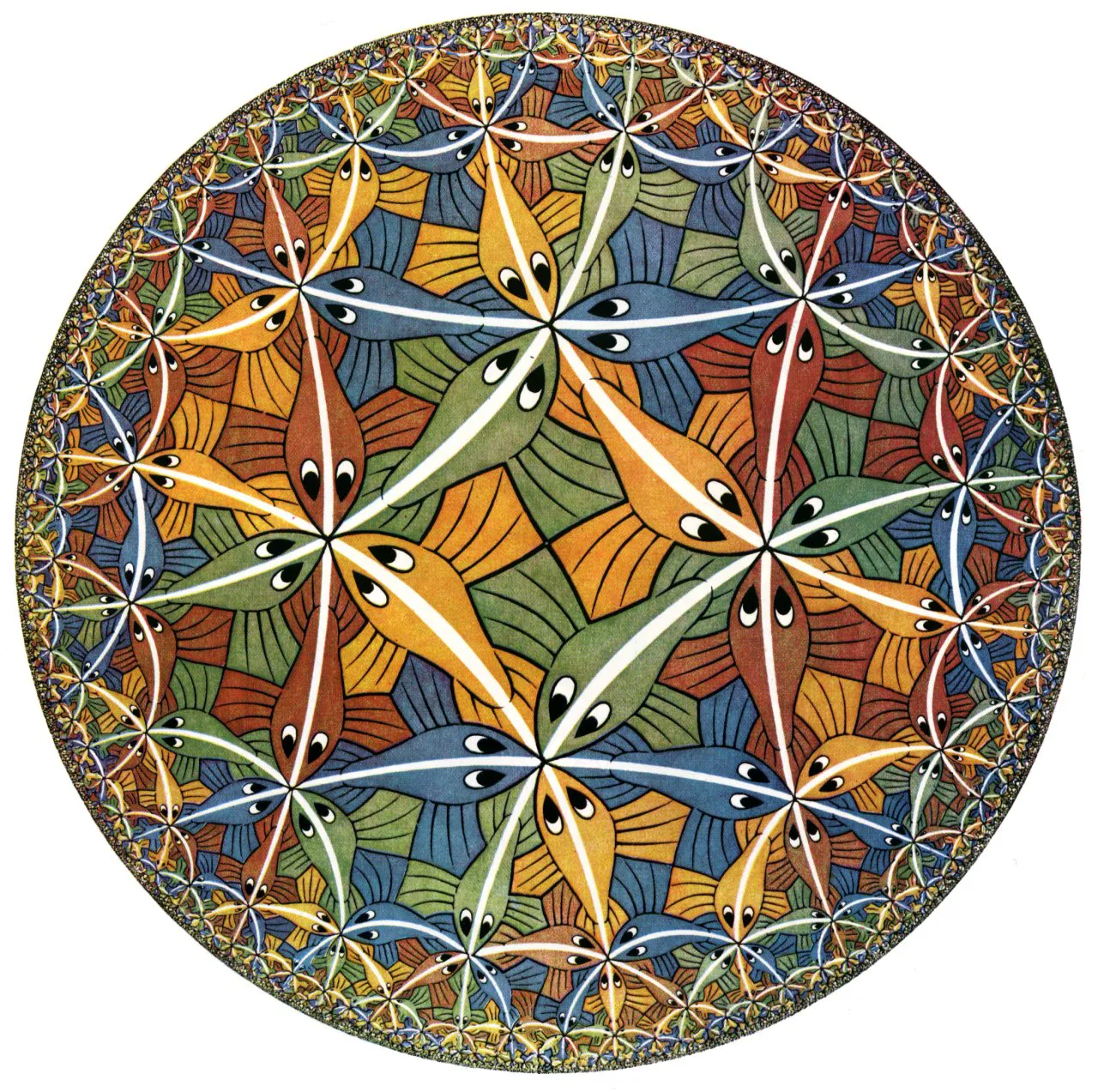
M.C. Escher’s 1959 woodcut Circle Limit III showcases the same negative curvature as a slice of anti-de Sitter space-time.
Physicists are fascinated with anti-de Sitter space because it curves in an exotic way that allows an infinite volume of space to fit inside a finite boundary. Even more strikingly, there appears to be a way of recasting any event taking place in the anti-de Sitter space in terms of particles living on the boundary, which play by completely different physical rules. A solar system in the central anti-de Sitter region, for instance, can be described as a collection of particles scattered around the boundary that obey only quantum theory and have no sense of gravity or space-time at all.
The main question for Harlow was how the particles on the boundary, which have no concept of space-time, could possibly capture the experience of an inhabitant of a planet in the central region, for whom space-time is undeniably important. Naïvely, we might expect to run into a problem where boundary events could reverberate instantaneously throughout the middle — a place where effects should take time to propagate. Because of that issue, the relationship between the boundary particles and the central space-time should be loose, so that boundary changes don’t immediately affect the middle, but not so loose that the boundary completely loses track of what’s going on in the center.
“You need to be independent of all the pieces of the system, but not independent of the system, which is like aaargh,” Harlow said, throwing up his hands in frustration.
Eventually, Harlow realized that a cadre of researchers had already solved the problem. They hadn’t been thinking about the structure of space-time at all. They were inventing ways for quantum computers to correct their errors.
To get a sense of how error correction embodies the Goldilocks relationship Harlow sought, consider a simple scheme for encoding a classical one-bit message into a three-bit transmission. To indicate 1, transmit 111. To indicate 0, transmit 000. Even if an error occurs, the receiver can just take a majority vote. It will still understand 001 to mean 0, or 011 to mean 1. A single error doesn’t spoil the message, because the information lives in all the digits. The message is independent of each individual piece, but not independent of the whole transmission — just what Harlow needed. Correcting quantum errors in qubits (as opposed to classical bits) requires more complicated schemes, but the two problems share this feature of smearing information between multiple pieces. In 2014, Harlow collaborated with Almheiri of AMPS and Xi Dong of the University of California, Santa Barbara to explain how quantum error-correcting codes could spread out anti-de Sitter space-time information among boundary qubits.
The gist of the idea was the following. Imagine the central point in anti-de Sitter space as a one-bit message. The boundary particles are the digits of the transmission. Divide the boundary into three arcs. The particles of any one arc know about the anti-de Sitter points within the adjacent region. But they do not know about points outside that region. No single arc knows about the central point, a situation reminiscent of how no single transmission digit suffices to reconstruct the message.
In anti-de Sitter space, particles along each of the three boundaries, here labeled A, B and C, know only about the points in the adjacent region.
Merrill Sherman/Quanta Magazine
But the center point does lie within the combined region belonging to any two arcs — echoing how two transmission digits suffice to decipher the message. In this way, error correction seemed to be a suitable language for understanding empty anti-de Sitter space from two perspectives: either as vanilla space-time or, intriguingly, as a collection of spaceless quantum qubits.
Combine any two regions, and the boundary particles along that larger region can now sense the point in the center. From left: The combination of regions A and B, B and C, and C and A.
Merrill Sherman/Quanta Magazine
“This is sort of surprising,” DeWolfe said. Quantum information isn’t just for building quantum computers. “It turns out that these are important enough ideas that quantum gravity seems to use them.”
Harlow had succeeded in linking the two ways of looking at space-time. The only problem was that the framework fell short of its intended purpose. When the space-time contained a black hole, quantum error correction failed.
As early as 2012, physicists had floated the notion of tackling the black hole interior with error-correcting codes. But once more, the conflicting perspectives in Hawking’s calculations had stumped them. An astronaut inside the event horizon would see infalling radiation partners rain down indefinitely. The black hole’s information capacity, if you imagine it as a cosmic hard drive, goes up and up throughout its life.
Meanwhile, an astronaut outside a black hole in its golden years would see it literally shrinking in size as it evaporates. To achieve the aspiration of squaring the two perspectives with error correction, Harlow seemed to need a way of encoding the growing interior into its shrinking boundary, a task like asking a sailor to fit the message “SOS” into a one-character transmission.
“The story excluded the interior of black holes,” said Christopher Akers, a researcher at MIT who as a second-year graduate student in 2016 was inspired by an influential error-correction paper of Harlow’s. “That sat weirdly with me, so I spent a lot of time thinking about how you might include black holes in a better way.”
It would take him four years to find one, and another year to help convince Harlow that it made any sense.
A Recipe for Information Escape
While Harlow and Akers separately puzzled over the inside of a black hole, a constellation of researchers were on the verge of cracking the exterior. Penington, a rising British physicist, was one of the key players. He’d missed the firewall drama at the Santa Barbara conference, since back in 2013 he was 21 years old and in the middle of his undergraduate studies at the University of Cambridge.
When Penington visited Stanford in 2015 as a prospective graduate student, he felt torn between studying quantum gravity and quantum information for his doctorate. Then he met Hayden. Penington was surprised to discover that his mother — Frances Kirwan, a mathematician at Oxford — had been one of Hayden’s graduate supervisors, and that Hayden, a native Canadian, had helped his mother plan a canoe trip to rural Ontario that he had gone on when he was 8. He was even more surprised to learn that Hayden was at the heart of the effort to explain black holes with qubits, blending Penington’s two interests. The pair decided to work together.
Hayden and Penington started with what they thought was an abstract problem about imperfect error-correcting codes, publishing a splashy quantum information paper in 2017. That work didn’t mention black holes or space-time, but the next year they brought their codes to anti-de Sitter space. Eventually, following a formula developed in 2014 by Netta Engelhardt, a fellow millennial physicist, Penington grew to suspect that a particular region of anti-de Sitter space was tracking entropy, a quantity related to the information capacity of the cloud of entangled Hawking radiation that billows out from a black hole. He spent the winter of 2018-2019 singlehandedly working out the details to check his hunch.
“It’s the hardest I’ve continuously worked on physics in my life,” Penington said. “I was on holiday in Mexico over Christmas but secretly thinking about it the whole time. My friends kept asking, ‘Why are you being so quiet?’”
Around the same time, Engelhardt was slogging through an essentially identical calculation. In early 2019, she joined forces with Almheiri and Marolf of AMPS and Henry Maxfield at Stanford to use the 2014 formula, which gives the entropy in a situation involving gravity, to study the information in the entangled radiation outside the black hole.
The two teams got the same answer, which they unveiled in coordinated papers in May 2019. The calculations amounted to counting the “heads” in the exterior radiation — which tells you how many entangled “tails” are hidden inside the black hole. For young, empty black holes, the number of separated coin faces rises as the event horizon splits Hawking pairs, just as Hawking expected. But with age, the number of separated faces starts to fall — implying that the black hole has filled up and is somehow emptying information out into the exterior radiation, just as quantum mechanics requires.
Merrill Sherman/Quanta Magazine
“These May papers, they really were amazing,” Harlow said. He was impressed they had “the guts to do the calculation. I would have thought it was too hard.”
At last, Penington, Engelhardt and their collaborators thought they understood what was happening outside the black hole. Information was indeed leaking out into the radiation, as many physicists had assumed. This fact had three crucial consequences.
First, it narrowed the possibilities for Hawking’s mistake. The radiation couldn’t be truly random, so why did the otherwise trustworthy semiclassical physics suggest that it was?
Second, it moved their frontier of understanding from outside the black hole to the interior. How would an astronaut just inside the event horizon of an old black hole experience the evaporation?
Finally, it suggested that Hawking’s semiclassical framework was almost correct, and that taking the first step into the interior shouldn’t require a full-blown theory of quantum gravity. They had succeeded in analyzing the exterior using familiar space-time ingredients. But with just a slightly tweaked recipe (the 2014 entropy formula) they found that information does escape the interior. The calculations made them feel confident that the semiclassical view of the black hole interior need not be abandoned. Firewalls increasingly looked like a step too far.
“If we throw out the interior description, we’re throwing out the baby with the bathwater,” Engelhardt said. “There is a way to use semiclassical gravity to do a calculation which is correct.”
Engelhardt, an expert in gravitational entropy, had some of the pieces, and it seemed that Harlow had a few more. Engelhardt’s office at MIT shares a wall with Harlow’s, so it was only natural for them to join forces. Around the same time, Akers moved to MIT to become their postdoc, and the three of them began to pick away at the problem.
How to Break Space-Time on a Quantum Computer
As the pandemic forced the world inside in early 2020, the trio of academics moved their black hole thought experiments from the blackboards of MIT to the digital environment of Zoom.
Their goal was to gather up all the threads and develop something of a conversion process for turning the semiclassical interior perspective into the quantum mechanical exterior perspective. Such a theory would be of use to an astronaut just inside the black hole. She could take a snapshot of her surroundings, run it through the procedure, and get back a picture that told her what a colleague outside was seeing. While the two photographs might seem to capture different events, Rashomon style, the conversion should reveal the scenes to be secretly compatible. It would be a more sophisticated revival of Susskind’s vision of complementarity.
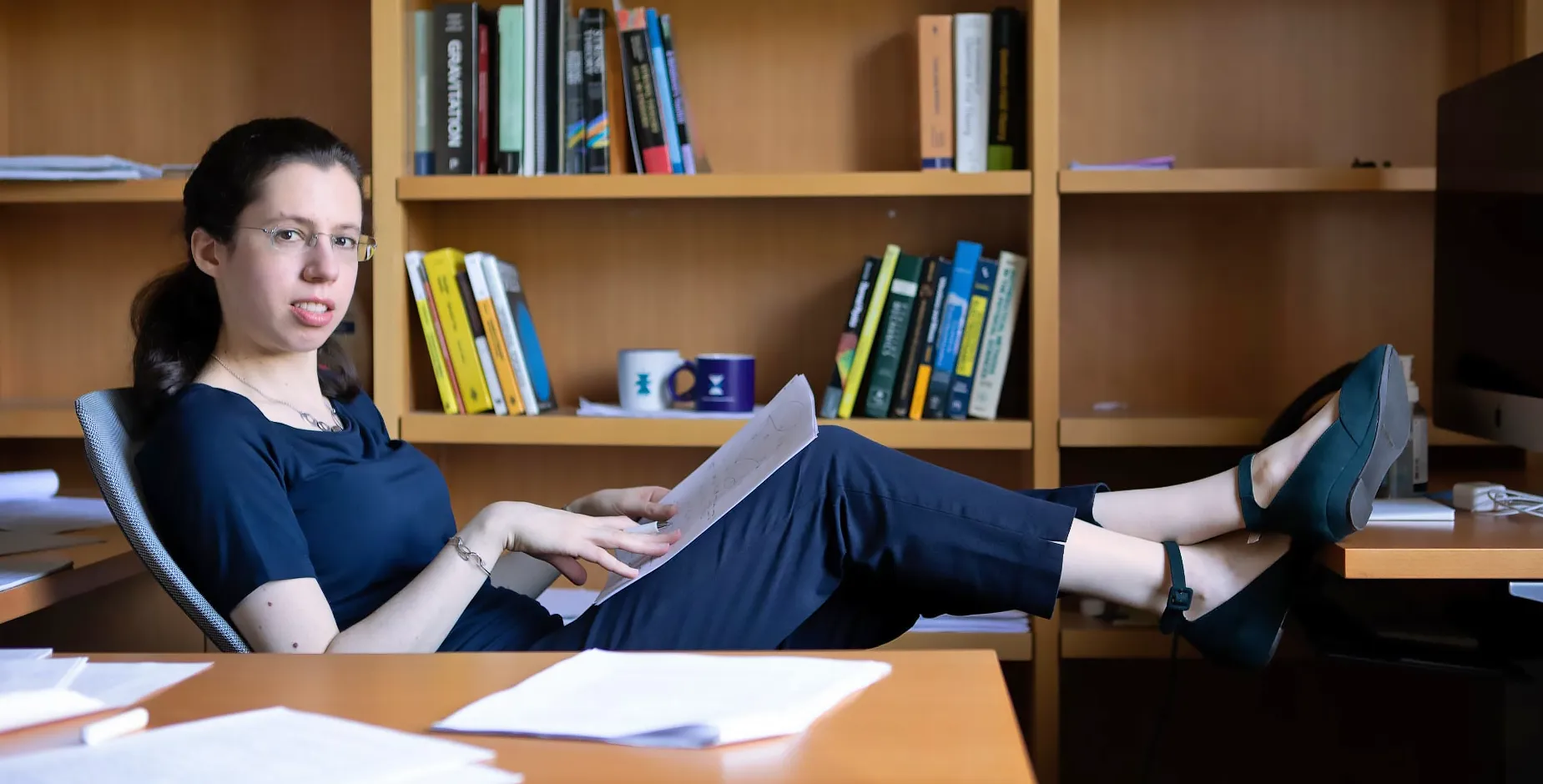
Netta Engelhardt, a physicist at MIT, has proposed a way to track information in systems that feature gravity.
Tira Khan for Quanta Magazine
Akers had already convinced himself that the conversion program should be written in the language of quantum error correction, as Harlow had already worked out for empty space. The semiclassical interior would be the message, and the quantum exterior would be the transmission. And given that the interior seemed to grow inside a shrinking horizon, they were just going to have to invent an error-correcting code that could cram an SOS into a single S.
Akers faced skepticism from his colleagues. The way in which the encoding would have to delete information inside the black hole violated the quantum mechanical prohibition against information loss. If the interior astronaut burned her mission log, she might not be able to reconstruct a replica from the ashes.
“If you’re modifying quantum mechanics, people will think you’re crazy, and usually they’ll be right,” Harlow said. “I was hesitant.”
Later that year, an MIT graduate student (now at Stanford) named Shreya Vardhan joined the crew. She did some concrete entropy calculations that finally convinced everyone that lightly breaking quantum mechanics inside was the only way to completely save it outside.
“Shreya and Chris in particular were pushing that in different ways,” Harlow said. “Shreya broke down the last barrier for me, and I realized that this really does make sense.”
Akers had been working with Penington, so he got involved too. The effort took a few years of on-and-off work. And just as they sat down to write up their results, three-fifths of the team simultaneously came down with Covid-19. But last July they finally posted a preprint detailing their theory of how the black hole interior could be encoded in its exterior with the world’s weirdest error-correcting code.
Here’s how it works. A self-sacrificing astronaut inside the black hole records the configuration of all the photons, electrons and other particles surrounding her and the black hole — a file of quantum data made up of a bunch of qubits capturing her semiclassical experience. Her goal is to understand the quantum perspective of her partner outside at that moment. The group developed a two-step algorithm that one could imagine running on a quantum computer for converting that interior snapshot.
First, the program scrambles the semiclassical qubits almost beyond recognition using one of the most random transformations in mathematics.
Then comes the secret sauce. The second step involves postselection, a strange operation more commonly used by information theorists than physicists. Postselection lets an experimenter rig a random process to get a desired outcome. Say you want to flip a coin and get 10 heads in a row. You can do it, provided you have the patience to start over every time it comes up tails. Similarly, the encoding program begins measuring the semiclassical qubits but reboots every time it gets a 1. Eventually, when it has measured most of the scrambled qubits and successfully gotten a string of zeros, it throws those qubits away. The few remaining, unmeasured qubits represent the pixels of the quantum image of the black hole as viewed from the exterior. Thus, the code squeezes a large semiclassical RAW file into a compact quantum JPEG.
It’s “a lossy way to compress a lot of semiclassical information into a finite quantum space,” Hartman of Cornell said.
But there’s a big catch. How could such a program delete so much semiclassical information without erasing any essential details? The procedure implies that semiclassical physics is full of fluff — configurations of particles that the interior astronaut might observe that aren’t actually real. But semiclassical physics has been rigorously tested in particle colliders on Earth, and experimenters have seen no signs of such mirages.
“How many states are reliably encoded? And how well can the semiclassical theory do?” Hartman said. “Given that it has to be lossy, it’s not obvious that it can do anything at all.”
To explain how a flawed theory could perform so well, the team turned to the odd observation that Hayden and Harlow had made in 2013, that decoding the radiation for the AMPS experiment would take so many steps as to be effectively impossible. Perhaps complexity could be papering over cracks in semiclassical physics. The encoding wasn’t deleting configurations willy-nilly. It erased only certain arrangements of particles that were complex in the sense that they would take so long to come about that the interior astronaut could never expect to witness them.
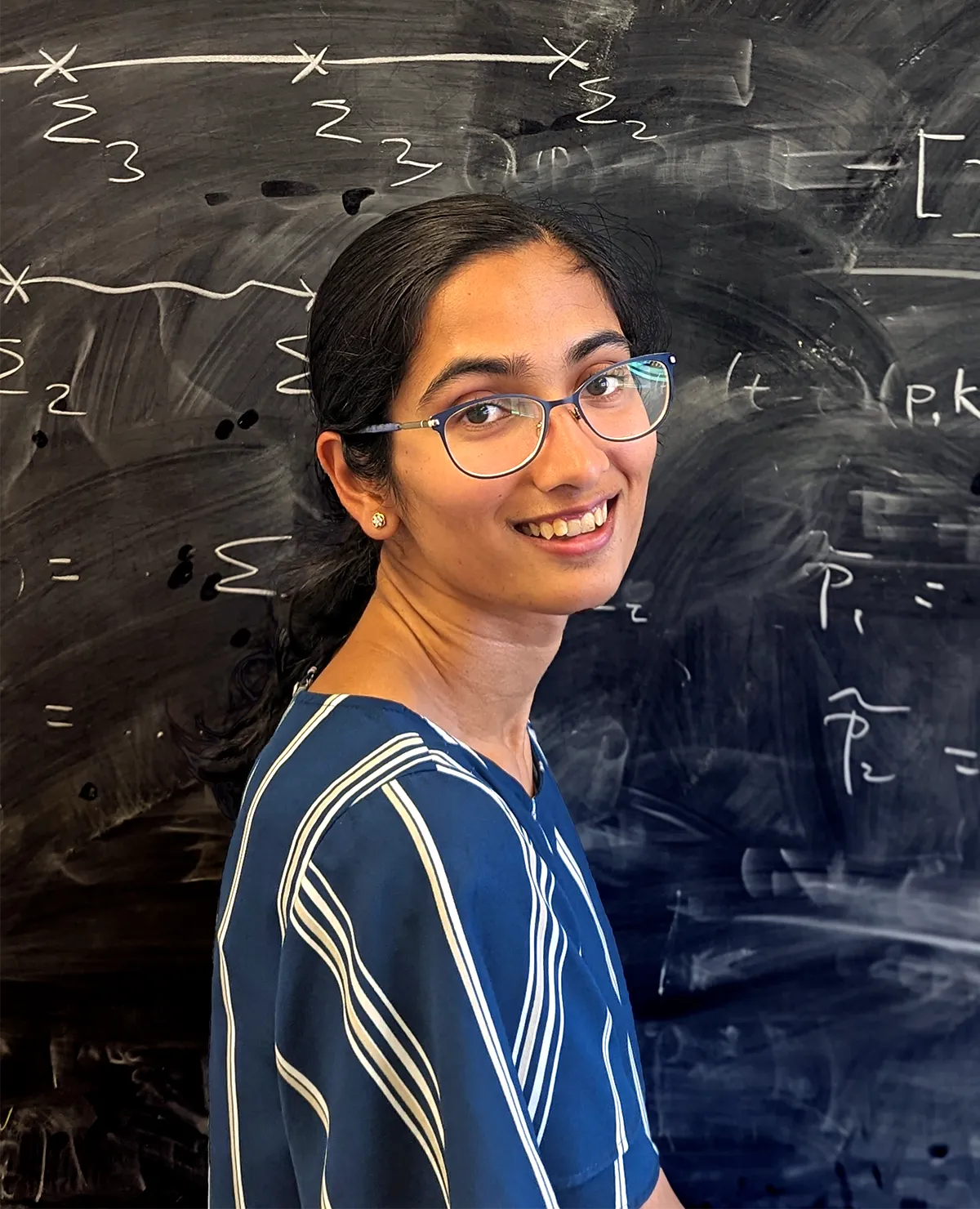
Shreya Vardhan, a physicist now at Stanford University, showed that error-correcting codes that delete information could make sense.
Alexander Nie
Making the case that the code left simple states essentially untouched made up the bulk of the work. The group argued that for any version of their two-step process, creating a complex semiclassical configuration with no counterpart from the outside perspective would essentially take an eternity — something like 10,000 times the current age of the universe just for a 50-qubit, subatomic speck of a black hole. And for a real black hole, such as M87 with its 1070-odd qubits, an experiment that broke semiclassical physics would take exponentially longer than that.
The team proposes that black holes highlight a new breakdown in the established framework of physics. Much as Einstein once predicted that Newton’s notion of rigid distances would fail at sufficiently high speeds, they predict that semiclassical physics fails for extremely complex experiments involving unthinkable numbers of steps and incomprehensible lengths of time.
Firewalls, the group believes, would be a manifestation of such unthinkable complexity. A real black hole like the one in M87 has only been around for billions of years — not nearly long enough for the semiclassical interior to break down in a firewall. But if one were able to do improbably complicated experiments, or if a black hole lived for an extremely long time, all semiclassical bets would be off.
“There’s a complexity frontier,” Harlow said. “When you start doing exponential things, then [physics] really starts being different.”
Saved by the Curse of Complexity
Once the physicists had convinced themselves that the code’s lossiness wouldn’t lead to noticeable cracks in semiclassical physics inside the black hole, the team investigated the consequences. They found that the apparent bug turned out to be the ultimate feature.
“It seems bad. It seems like you’re going to lose information because you’re deleting a lot of the states,” Akers said. But “it turns out it’s everything you ever wanted.”
In particular, it goes beyond the 2019 work in addressing how information gets out of the black hole. Or rather, it suggests that the qubits aren’t exactly inside to begin with.
The secret lies in the funky second step of the conversion, postselection. Postselection involves the same mathematical ingredients, namely the measurement of entangled partners, as a textbook quantum process that teleports information from one location to another. So, while the conversion process is not a physical event that plays out in time, it accounts for how information appears to switch from the interior to the exterior.
Essentially, if the interior astronaut converts a snapshot taken late in the black hole’s life, she’ll learn that the information that appears to reside in particles around her — or even in her own body — is from the external perspective actually floating in the Hawking radiation outside. As time goes on, the conversion process will reveal more and more of her world to be unreal. The instant before the black hole disappears, despite the astronaut’s impression to the contrary, her information will exist almost entirely outside, scrambled up in the radiation. By tracing this process, snapshot by snapshot, the group was able to derive Engelhardt’s entropy formula that had found information in the radiation in 2019. It too is a byproduct of the conversion’s lossiness.
In short, the conversion explains how an astronaut could unknowingly experience an interior that grows more and more detached from the reality outside as it matures. Hawking’s mistake, they argue, was to put himself fully in the boots of the interior astronaut and assume that semiclassical physics worked perfectly well both inside and outside the black hole.
He didn’t realize, as Harlow and company now believe, that semiclassical physics fails to accurately capture phenomena and experiments that require exponential complexity. Decoding the scrambled information in the radiation would take an exponentially long time, for instance, which is why his semiclassical analysis erroneously predicts the radiation to be featureless. The features are there; it would just take many, many times the age of the universe to uncover them.
In addition, there’s a reason why the interior’s information capacity appears to grow while the size of the black hole’s surface shrinks: The semiclassical calculation mistakenly includes a huge number of complex states that don’t have quantum counterparts outside. If physicists take into account the ways that complexity can mess with semiclassical physics, the clash between the space-time picture inside and the quantum picture outside evaporates.
“We now see a consistent way through the paradox,” Harlow said.
Black Hole Confusion
For all Harlow’s confidence, however, others in the black hole community have plenty of questions.
The major limitation is that the theories the code connects are extremely simple. The quantum mechanical description has a collection of qubits that radiates information. The semiclassical description has an interior cleaved from an exterior by an event horizon. And that’s it. There’s no gravity, and no sense of space-time. The code has the core features of the paradox, but it lacks many details that would be necessary to argue that real black holes operate in this fashion.
“The hope as always is you have a toy model that you’ve extracted all of the important physics and discarded all of the unimportant physics,” Maloney said. “There are pretty good reasons to think that’s true here, but nevertheless it’s important to be cautious.”
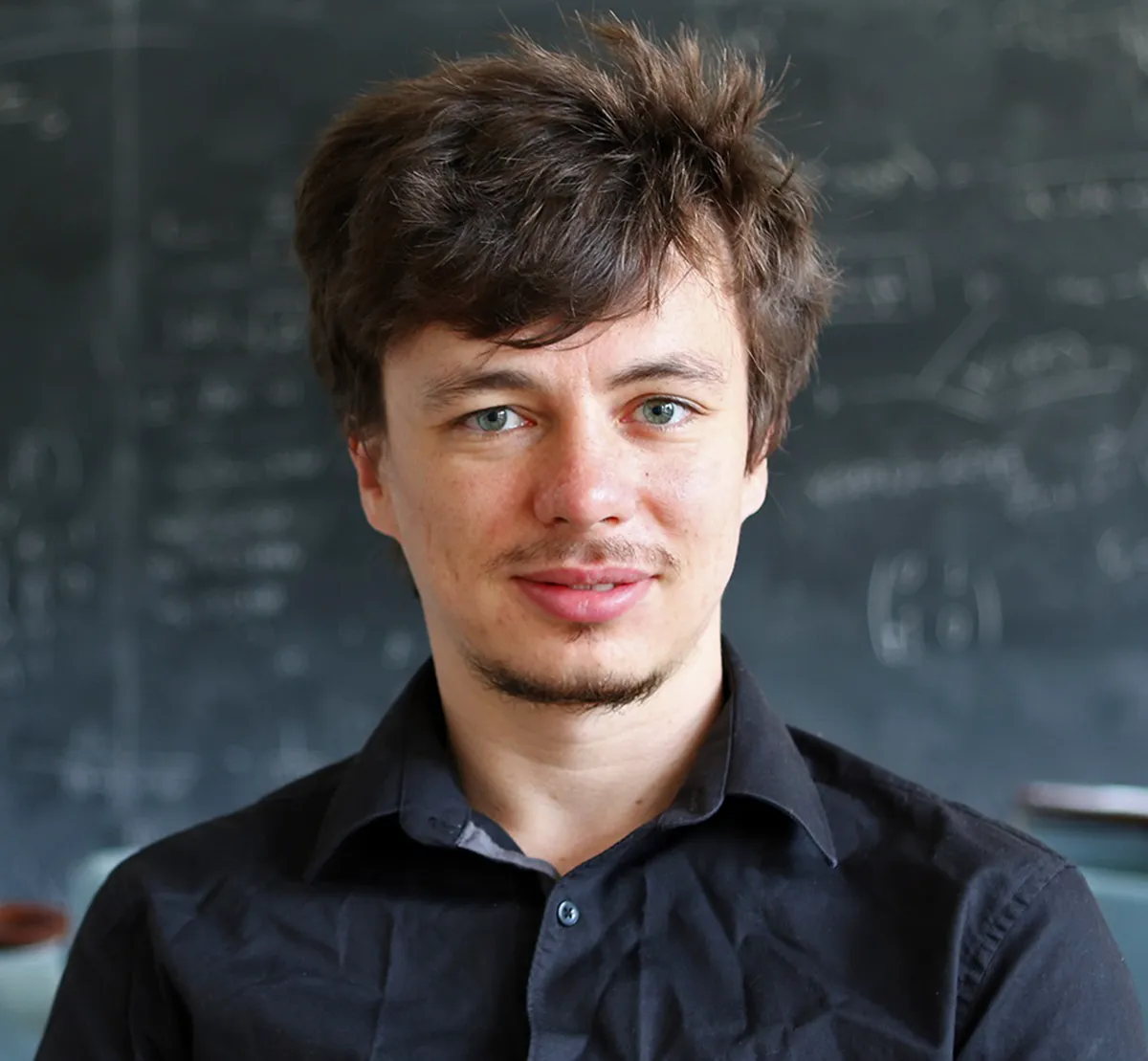
Geoff Penington of the University of California, Berkeley, works at the intersection of quantum information and gravity.
Lee Sandberg/Institute for Advanced Study
Plenty of alternative solutions exist, and real gravity could still resolve the paradox in one of those ways. Mathur of Ohio State, for instance, leads a research program studying one such option. While analyzing what would happen to a collapsing star in string theory, he and his collaborators found that strings may halt the collapse. They form a writhing mass, a “fuzzball,” whose intricate wriggling would stop an event horizon — and a paradox — from forming. Mathur raises various objections to the new solution and generally believes the lossy code to be an overly complicated proposal. “The information paradox was solved long ago,” he said. (By fuzzballs.)
Meanwhile Marolf, who worked with Engelhardt to spot the information in the radiation in 2019, suspects that their solution may be overly conservative. “My concern is that it’s almost too easy,” he said.
He chokes on the lossiness, which means that the code in its current form gives unique answers only to the interior astronaut. If an exterior astronaut takes a picture and wants to know what it says about the inside, he’ll have to guess at the semiclassical pixels the code erases. Even though those states are in some sense illusory, they’re essential for understanding the human experience inside. For some guesses, he might find a calm interior. In others, a raging firewall. No matter how refined the quantum theory is outside, it will never be able to say for sure what he’d find if he jumped in.
“It disturbs me a little bit,” Marolf said. “I would have thought that a theory which is fundamental should predict everything — including what we experience as reality.”
Lossiness on the Rise
Some skeptics of the initial proposal have since come around to the idea, including Isaac Kim, a computer scientist at the University of California, Davis, and John Preskill, a quantum physicist at the California Institute of Technology and one of the luminaries in attendance at the 2013 firewall showdown.
“We heard through the grapevine that this work was coming,” Kim said. “It sounded like something has to go wrong.”
Kim was unnerved by the use of postselection. Past applications of postselection had included blueprints for time machines and unreasonably powerful quantum computers, so its appearance leapt out as a red flag. He suspected that details missing from the initial code, such as how it works for an astronaut who measures radiation outside and then falls in, might combine with the postselection to muck up even the external perspective and delete information there.
Then in December, Kim and Preskill upgraded the code and found that the black hole safely continued to radiate information in the external picture. They also found that postselection did not serve as a loophole for the black hole to perform absurdly powerful computations — or launch astronauts back to the future.
“Remarkably within this model, even though you allow postselection, that doesn’t happen,” he said. “That’s what convinced me that something correct is going on here.”
DeWolfe and his collaborator Kenneth Higginbotham further generalized the lossy code in April. They also concluded that it could withstand infalling astronauts.
Other researchers have spent the last few months checking whether their favorite theories of gravity are hiding lossiness. In October, Arjun Kar of the University of British Columbia ported Harlow and colleagues’ lossy code into a well-known theory of 2D gravity and found that it held. “They really seem to have hit on something interesting about quantum error correction,” he said.
Continuing along this path — searching for lossiness in more theories of gravity — is the main way physicists hope to build or destroy confidence that real gravity actually works like this. Few dream of probing the code with an experiment.
“It’s not clear how we would ever test this account,” Aaronson said, “except for trying to further build a quantum theory of gravity on top of it and seeing whether that theory is successful.”
Harlow, however, is a dreamer. “I don’t think it’s impossible. It’s just hard,” he said, laying out the following thought experiment.
You put a tiny black hole in a box and capture every photon of Hawking radiation coming out of it, storing all that information in a quantum computer. Because that information would appear to exist inside the black hole from the point of view of an interior particle, manipulating the radiation could instantly affect the particle — a true action at a distance spooky enough to haunt any physicist. “There shouldn’t be anything I can do to the radiation that changes anything in the interior,” Harlow said. “That’s a breakdown that came because you crossed the complexity frontier.”
But even to fantasize about such an experiment, Harlow has to switch over to an eternal universe to give himself enough time, as activity in our expanding cosmos would peter out trillions of times over before one could hope to manipulate the radiation of even the tiniest of black holes. (Additionally, Susskind and others working on a related angle of the black hole puzzle have recently found overlapping ideas relating complexity and unfathomably long periods of time.)
Nevertheless, Harlow is undeterred by minor details such as the heat death of the universe. If impossible thought experiments involving trains traveling at nearly light speed were good enough for Einstein, he believes, they’re good enough for him.
“We still don’t have the trains, but [relativity] has consequences for various other things that we tested,” he said.
Harlow is the latest in a long line of black hole physicists with a relationship to physical evidence that casual observers might find surprising. After all, no one has ever seen one photon of Hawking radiation, and no one ever will. It’s far too weak, even if you parked the James Webb Space Telescope in orbit around a real black hole.
But that hasn’t stopped multiple generations of physicists, from Stephen Hawking and Leonard Susskind to Netta Engelhardt, Chris Akers and dozens more, from spiritedly debating how to handle the bundle of conflicts that come tumbling out of the black hole along with the theoretical bath of photons.
Even as they build and fortify their cases, they acknowledge that the only conclusive way to see whether black holes represent the ultimate cosmic prison or a fiery death sentence is to embark on the original unthinkable thought experiment.
“If there are two people who care about nothing more than resolving their disagreement, all they can do is jump in,” Penington said. “Either they both get vaporized instantly and they never resolve it anyway, or they make it inside and one of them goes, ‘Oh, fair enough, I was wrong.’”
Editor’s note: A number of the scientists featured in this article, including Daniel Harlow and Chris Akers, have received funding from the Simons Foundation, which also funds this editorially independent magazine. Simons Foundation funding decisions have no influence on our coverage. More details are available here.
